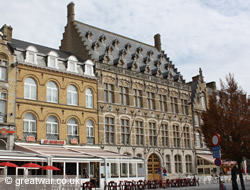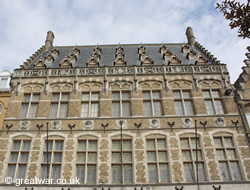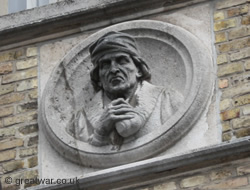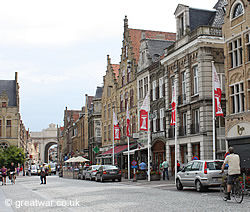The Kasselrij Building
One of the buildings on the Grote Markt, the market square, of Ieper/Ypres is the Kasselrij. It was completely destroyed by 1918 and was rebuilt in the 1920s as part of the reconstruction of the town.
Origin of the Building

|
The orginal pre-war Kasselrij building was built in 1501. At this time the feudal County of Flanders was divided into lots of small Castellania (or otherwise known as Bailliwicks), these being counties with a castle and a count at their centre. Operating the administration of the Castellania on behalf of the Count was a Viscount. He was at the head of each Castellany and, given that his function could be different according to a particular Castellan, he was usually in charge of one or all three of the military guard, the administration and/or the judicial system at the Castellan.
Dating from 1620s the fortified towns and castles across the Flemish counties had been so depleted by their Spanish rulers that the locals were determined to put up a resistance to the constant looting of livestock and possessions by marauding soldiers. Basing this resistance on the Spanish military model of having a captain in command of a company of men in the castle, noblemen of the Ypres area set themselves up as commanders with the French feudal title of “Châtelain”.
In 1810 the town of Ypres bought the building. From that time until 1914 the building was called the “Hôtel de Châtellenie” in French, as Ypres was generally French speaking in the pre-war period. There were grand banquets in the fine rooms.
Kasselrij Reconstruction

|
Reconstruction of the Kasselrij took place from 1921 according to a design by the town's principal architect Jules Coomans. The pre-war building had two dormer windows in the roof and a wrought iron balustrade over the guttering on the edge of the roof. There had been seven sculpted portrait busts along the front façade of the building which had represented the seven planets known to exist at the time.
When the rebuilding of the “Kasselrij” took place Coomans' design of the roof incorporated three rows of seven dormer windows in each row, which had not existed on the pre-war roof. The wrought-iron balustrade on the edge of the roof was also replaced with a heavier-looking sculpted stone balustrade.
Seven Deadly Sins

|
On the façade of the building seven sculptured medallions replaced the busts of the planets. The medallions were created by Alois De Beule depicting the “Seven Deadly Sins”. Looking at the building from the market square the “sins” are from left to right: pride, greed, lust, envy, gluttony, wrath and sloth.
This building was finished before the rebuilding of the Cloth Hall (Lakenhalle) and the Town Hall were complete. Provisionally this building, the Kasselrij, served as the Town Hall until the rebuilding of the Cloth Hall was finished. The Town Hall moved into its location in the Nieuwerk in the eastern wing of the Cloth Hall in 1967.
The Kasselrij building currently houses the Commercial Court, the Juvenile Court and the Justice of the Peace Court.
Location of the Kasselrij Building
The Kasselrij is located at number 10 Grote Markt on the northern side of the Grote Markt (market square).
Related Topic
The Grote Markt (market square) is surrounded by gabled buildings housing shops, cafés and hotels.
Acknowledgements
The Reconstruction of Ieper: A Walk Through History, by Dominiek Dendooven and Jan Dewilde
Ieper in oude prentkaarten, by D Masure





